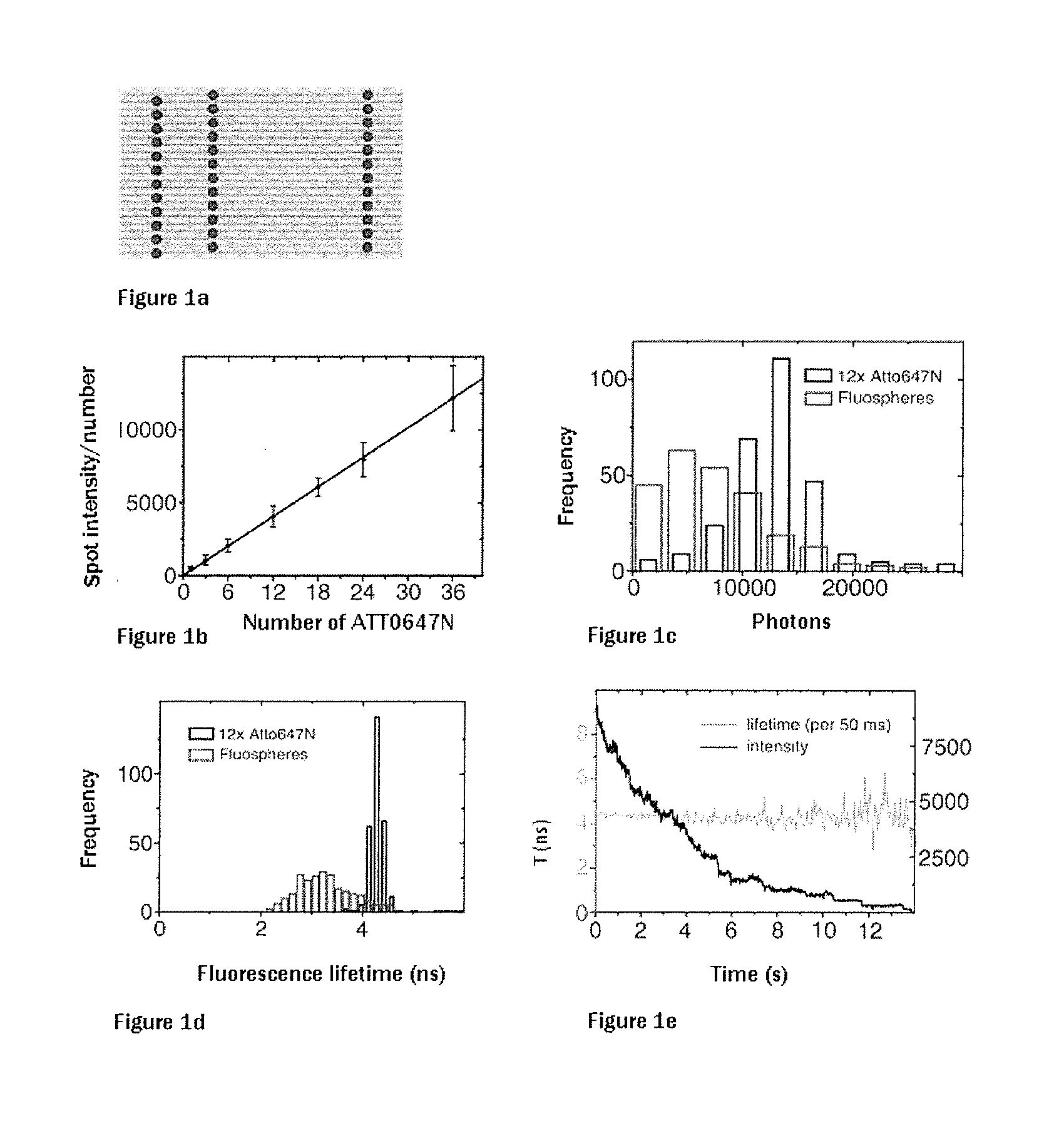Dna-origami-based standard
a technology of dna-origami and standard, applied in the field of dna-origami-based standard, can solve the problems of limited quantity analysis using such microscopy techniques, limited availability of standardized samples, and large size dimensions, and can only be combined with great difficulty with the requirements on the molecular scal
- Summary
- Abstract
- Description
- Claims
- Application Information
AI Technical Summary
Benefits of technology
Problems solved by technology
Method used
Image
Examples
example 1
Brightness Standards Based on DNA Origami
[0058]The ATTO647N-labeled short DNA segments were used in the self-assembly of the DNA origami. FIG. 1a shows a corresponding diagram of a rectangular DNA origami having 36 fluorophore positions. FIG. 1b shows the analysis of the spatially integrated photon number based on the number of labeling molecules. The linear direct dependence of the number of photons as a measure of the brightness of the number of incorporated fluorophores can be clearly seen. To this end, DNA origami having 12, 24 and 36 ATTO647N molecules were used. It is clear that there is no discernible self-quenching which leads to a reduction in the photons per spot. In contrast, experiments with commercially available beads in which the fluorophores are randomly distributed show that self-quenching occurs (FIG. 1c). Furthermore, the lifetime of the fluorescence in the case of the DNA origami sample is very homogeneous in contrast to the commercially used beads (FIGS. 1d and ...
example 2
Standards for STED Microscopy
[0060]STED (stimulated emission depletion) was the first super-resolution microscope technology which breached the diffraction limit. DNA origami rulers were prepared here for both pulsed and continuous STED. To this end, corresponding rectangular origami were prepared with a distance of 71 nanometers between the two lines composed of, in each case, 12 ATTO647N molecules (see FIG. 2a). Said DNA origami were immobilized on polylysine-coated cover slips and covered with a polymer layer. Using STED technology, it was possible to resolve the interval between the two lines composed of, in each case, 12 molecules, and it was possible by means of STED microscopy to determine the distance between the two lines to 71±3 nm, as shown in FIG. 2b. Using STED with pulsed excitation, it was also possible to resolve lines at an interval of 44 nanometers. Similar results could be achieved with Alexa 488 fluorophores (data not shown).
example 3
Standards for Ultra-High Resolution Imaging
[0061]The resolution of super-resolution microscopy below the diffraction limit is normally limited by (i) photobleaching, (ii) the measured photon numbers in an “on state” and the on / off cycle or simply because of the stability of the structure. Here, rectangles having two ATTO647N molecules at intervals of 6, 12 and 18 nm were designed in DNA origami (see FIG. 3a). Said DNA origami were immobilized with 5 biotin-labeled strands. To avoid limitation by the number of photons, the fluorescence of the dyes was captured until photobleaching. Subsequently, the positions of the individual dyes were determined by subtracting the point spread function of the longer-lived dye from the point spread function before the first photobleaching step. The individual molecules were localized in reverse order of the photobleaching and the intensity distribution of the second molecule was subtracted from the first part of the transition. By way of example, it...
PUM
| Property | Measurement | Unit |
|---|---|---|
| distance | aaaaa | aaaaa |
| pH | aaaaa | aaaaa |
| wavelength | aaaaa | aaaaa |
Abstract
Description
Claims
Application Information
 Login to View More
Login to View More - R&D
- Intellectual Property
- Life Sciences
- Materials
- Tech Scout
- Unparalleled Data Quality
- Higher Quality Content
- 60% Fewer Hallucinations
Browse by: Latest US Patents, China's latest patents, Technical Efficacy Thesaurus, Application Domain, Technology Topic, Popular Technical Reports.
© 2025 PatSnap. All rights reserved.Legal|Privacy policy|Modern Slavery Act Transparency Statement|Sitemap|About US| Contact US: help@patsnap.com



